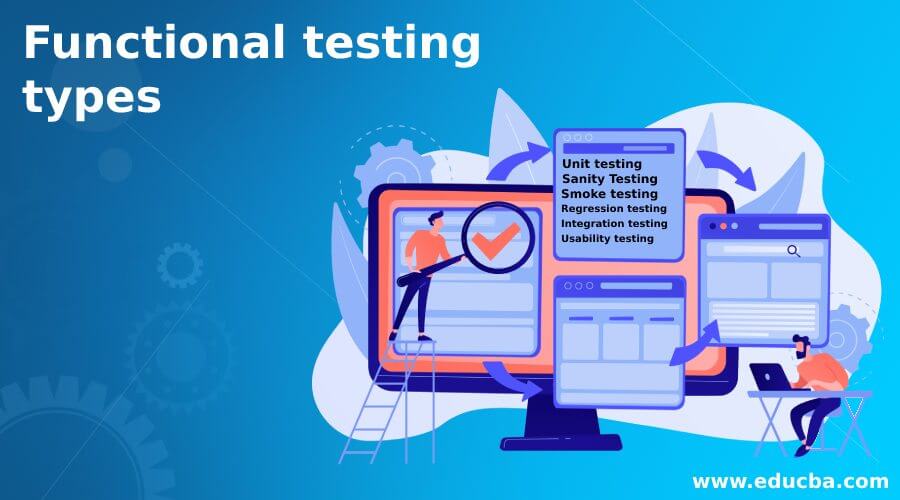Updated March 31, 2023
Introduction to Functional testing types
Functional testing is a type of software testing that validates the functional requirements against the software system. Its main goal is to test each function of the software applications. It validates the functional requirements using specific input and compares the generated output with expected. In addition, it tests the application’s user interface, database, API, security, client-server communication, and other functionality. Functional testing is categorized into several types, namely unit testing, sanity testing, smoke testing, regression testing, integration testing, and usability testing. In this article, we are going to discuss these types of functional testing.
Types of functional testing
Let’s discuss the types of functional testing in detail.
- Unit testing: Unit testing is a type of functional testing in which individual components and units are tested. Its main goal is to check the function of each and every component of the software and validate whether it is working as expected or not. Unit testing is done by the developers during the development of the system. It helps developers to test the code base and enables them to make changes quickly. In addition, it helps to fix bugs at an early stage and saves costs. Unit testing can be done using various automated tools such as JUnit, NUnit, JMockit, PHPUnit, EMMA; due to the modular nature of the unit testing, we can test the parts of the system without waiting for others to be completed.
- Sanity Testing: Sanity testing is used to ensure that the code changes that are made are working as properly. It checks whether the testing for the build can proceed or not. Its main goal is to validate the functionality of the application, not detailed testing. Its main function is to check whether changes or the proposed functionality are working as expected. If the result of sanity testing fails, the testing team will reject the system to save time and money. Sanity testing is performed only after the system has passed the smoke testing, and the quality assurance team has accepted for further testing. During sanity testing, the tester first detects the newly added components and changes. After that, they analyze the components and their attributes and modify them to check their work. Then they inspect and assess all the linked parameters and components and perform the testing.
- Smoke testing: Smoke testing validate whether the build software is testable or not. It is done at the time of building software. For example, it is done when the key features of the applications are not working or when key bugs are not fixed. Smoke testing is also known as build verification testing as it verifies every build is testable or not. It is performed at the early stage, detects the bugs, and sends it to the development team to have enough time to fix the bugs. Smoke testing can be performed in two ways, formal smoke testing and informal smoke testing. It enables uncovering obvious errors, which saves time and effort for the testing team.
- Regression testing: Regression testing is used to check whether the changed program has adversely affected the existing features of the application or not. It gives confirmation that the newly changed code does not have any side effects on the existing functionality. It is performed whenever there is a requirement of the changes in the code, and we need to test whether that modification affects the system or not. It can be performed manually or automatically, based on the requirements for the system. For automation testing, it makes use of tools such as Selenium, Quick Test Professional, and Rational Functional Tester.
- Integration testing: In integration testing, the individual components and units are combined together and tested as a whole. Its main goal is to check the faults in the interaction between integrated units. It uses test drivers and test stubs. It uses Four approaches to perform testing: the Big bang approach, Top-down approach, Bottom-up approach, and Hybrid approach. In the big bang approach, all components are combined together and tested in one go. In the top-down approach, Top-level components are tested first, and lower-level units are tested step by step after that. In the bottom-up approach, bottom-level units are tested first, and then upper-level units are tested in step by step manner; the hybrid approach combines the top-down approach and bottom-up approach.
- Usability testing: Usability testing is used to evaluate how easily the user can use the software. In other words, we can say that it checks the user-friendliness of the system is also known for UX testing, i.e., user experience testing, as it observes the user’s experience user while interacting with the system. It helps the tester to check and measure the effectiveness-based design. It involves four phases – The test planning phase, Test execution phase, Data analysis phase, and Reporting phase.
Recommended Article
This is a guide to Functional testing types. Here we have discussed the various types of functional testing and how they help the tester to check the function of the software to deliver the bug-free system to the user. I hope you enjoyed the article. You may also look at the following articles to learn more –



